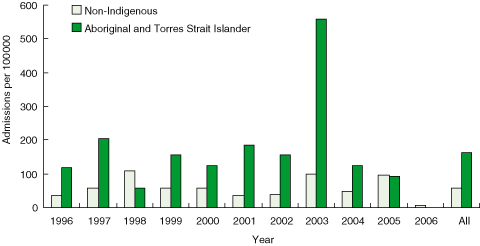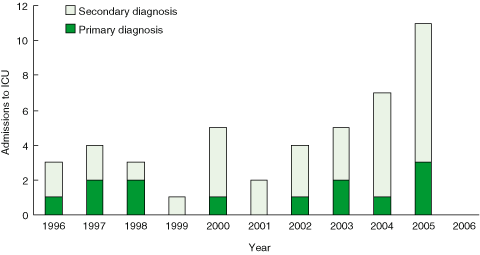In Australia, influenza vaccination is currently recommended for people at high risk of complications from influenza infection. Among children aged older than 6 months, only those who have specified chronic diseases are considered at risk (Box 1). In Australia and internationally, evidence has been mounting of high morbidity and mortality from influenza in children aged under 2 years.1-4 The 2003–2004 influenza season in the northern hemisphere had particularly high mortality. In the United States, 153 children died from influenza-associated illness (0.21 deaths per 100 000). Most were aged under 5 years, and 40% were under 2 years, while 47% of those who died were children who had previously been healthy.5
A similar picture emerged from a New South Wales study in 2003 that examined paediatric intensive care admissions involving influenza A infections.6 There were 22 admissions, three resulting in death, and 16 of the admitted children were younger than 4 years. Over 80% of patients, and two of the three who died, did not belong to the specific high-risk groups currently recommended for annual influenza vaccination by the National Health and Medical Research Council (NHMRC).7
All hospital separation codes, for primary and secondary diagnoses, were examined individually for each child with an influenza diagnosis to determine any pre-existing chronic disease. The NHMRC criteria for children at high risk of complications from influenza infections that were current at the time7 were used to determine the proportion of children who would have been recommended for the influenza vaccine (Box 1).
Hospital admission data on Aboriginal and Torres Strait Islander children were examined separately because of reports of higher morbidity from influenza infections in Indigenous children.8 The data were aggregated across the ages 0 to 4 years because of the small numbers of children involved.
An audit of a random sample of case notes from three large Adelaide metropolitan hospitals with paediatric units was undertaken to check the accuracy of the ISAAC database for this study. Random case notes were selected by using the Stata, version 9 (StataCorp, College Station, Tex, USA) random-sample generation function. The sampled hospitals are sites for 68% of all influenza-related admissions for children under 5 years. The case notes of 160 admissions (24.7% of all admissions) were audited, with the sample stratified across the different hospitals according to the proportion of influenza-related admissions by hospital. The case notes were reviewed to ascertain the accuracy of the influenza diagnosis (by review of all laboratory results) and whether the admitted child had pre-existing illnesses, as described by the NHMRC (Box 1), that would put them at higher risk of influenza infection. The case note results were compared with the results from the ISAAC database. Errors in the diagnosis codes that resulted in an incorrect coding of influenza or a wrong categorisation as high or low risk for influenza-related complications were recorded. Data were analysed with Stata, version 9.
The mean annual admission rates per 100 000 children were highest in children aged under 1 year and decreased with age (Box 2). The overall mean annual admission rate was 62.5 per 100 000.
Examination of other diagnoses apart from the influenza diagnosis found that most children younger than 5 years admitted to hospital did not have an underlying illness that would put them at increased risk of influenza-related complications according to NHMRC criteria. The percentage of children at low risk differed slightly across the age groups, and was highest in infants aged 6–11 months (Box 2).
Aboriginal and Torres Strait Islander children made up about 10% of all admissions every year and had a mean admission rate of 161.8 per 100 000 of the population of Aboriginal and Torres Strait Islander children younger than 5 years (Box 3).
There were 45 admissions to ICUs over the 11 years, 20 of which required mechanical ventilation (44%), with a median ventilation time of 193.5 hours (Box 4). Of these children, 76% were aged under 2 years and 36% under 6 months. Almost half (47%) did not meet the NHMRC criteria for high risk of influenza complications.
The overall admission rates in this study are consistent with similar studies reported elsewhere. Over the years 2000 to 2002, a national Australian study found an average admission rate of 49.5 per 100 000 children in the 0–4-years age group, and 26 per 100 000 in adults older than 60 years.8 Rates in older adults ranged from 15 per 100 000 in those aged 60–64 years to 52 per 100 000 in those older than 85 years.8 Our study found a slightly higher rate of hospitalisation in children younger than 5 years, as it included secondary diagnoses, as well as data over 11 years that included years that had particularly high incidences of influenza infection.
Very high rates of hospital admission in Aboriginal and Torres Strait Islander children have been reported. A national admission rate of 127.3 per 100 000 in 0–4-year-olds in 2000–2002 has been reported.9 Our study found a slightly higher admission rate of 161.8 per 100 000, on average, for children aged 0–4 years over the 11 years of the study. The numbers are small, so this analysis should be repeated with national data over a longer period for better understanding of this potentially highly significant, inequitable disease burden.
The limitations of hospital separations data for research should be noted. The overcounting of influenza diagnoses is contrasted with published evidence of an undercount in hospital discharge diagnoses of influenza due to non-diagnosis: a US study found that the hospital data underestimated actual influenza-related hospitalisations by 35%.10 It is therefore difficult to determine the true influenza-associated admission rate in children, although figures 18% less than were found in this study would still constitute a high admission rate. The audit also found that using secondary diagnoses to determine whether a child had a pre-existing illness was a reasonably accurate method, with ISAAC data being inaccurate in only 4.1% of cases. As such, although there is some uncertainty in the exact admission rate, the results suggest that healthy children under 2 are a high-risk group for influenza complications.
Children admitted to more than one hospital with a diagnosis of influenza would have been counted as distinct admissions, which would potentially overestimate the burden of illness. The study was, however, able to control for this within the same hospital, and over the 11 years, this occurred infrequently. The proportion of admissions related to nosocomial influenza infections was not able to be determined, which may have overestimated community-acquired infections.11 In addition, there was no information on the vaccination history of the admitted children, although it is thought that the rate of vaccination in Australian children is likely to be very low.12
Healthy children younger than 2 years and Aboriginal and Torres Strait Islander children younger than 5 years in SA have had a high burden of illness from influenza, with hospitalisation rates that exceed those in older adults. This may have implications for the target group recommendations for influenza immunisation. However, an assessment of the efficacy, feasibility, safety and cost-effectiveness of vaccination in the Australian context would be required to support an expansion of the influenza immunisation program target groups to include those groups identified in this study.12,13
1 National Health and Medical Research Council criteria for high risk of influenza complications in children older than 6 months*
Chronic suppurative lung disease
Chronic cardiac conditions
Chronic conditions requiring regular medical follow-up or hospitalisation in preceding year (eg, chronic renal failure, diabetes, immunocompromised)
Severe asthma
Immune deficiency
* Based on The Australian immunisation handbook (8th ed, 2003).7
2 Admissions to hospital for influenza in children aged under 5 years in South Australia, 1996–2006, and number considered at low risk of complications
Received 17 September 2007, accepted 18 December 2007
- Katina D’Onise1
- Jane C A Raupach2
We would like to acknowledge Maureen Watson, Manager, South Australia Immunisation Coordination Unit and Dr Ann Koehler, Director of Communicable Disease Control Branch, SA Department of Health for their contribution to the study.
None identified.
- 1. Beard F, McIntyre P, Gidding H, et al. Influenza related hospitalisations in Sydney, New South Wales, Australia. Arch Dis Child 2006; 91: 20-25.
- 2. Bueving H, van der Wouden J, Berger M, et al. Incidence of influenza and associated illness in children aged 0–19 years: a systematic review. Rev Med Virol 2005; 15: 383-391.
- 3. Izurieta H, Thompson WW, Kramarz P, et al. Influenza and the rates of hospitalization for respiratory disease among infants and young children. N Engl J Med 2000; 342: 232-240.
- 4. Neuzil KM, Mellen BG, Wright PF, et al. The effect of influenza on hospitalizations, outpatient visits, and courses of antibiotics in children. N Engl J Med 2000; 342: 225-231.
- 5. Bhat N, Wright JG, Broder KR, et al. Influenza-associated deaths among children in the United States, 2003–2004. N Engl J Med 2005; 353: 2559-2567.
- 6. Milne B, Williams S, May M, et al. Influenza A associated morbidity and mortality in a paediatric intensive care unit. Commun Dis Intell 2004; 28: 504-508.
- 7. National Health and Medical Research Council. The Australian immunisation handbook. 8th ed. Canberra: NHMRC, 2003.
- 8. Brotherton J, McIntyre P, Puech M, et al. Vaccine preventable diseases and vaccination coverage in Australia, 2001 to 2002. Commun Dis Intell 2004; 28 Suppl 2: vii-S116.
- 9. Menzies R, McIntyre P, Beard F. Vaccine preventable diseases and vaccination coverage in Aboriginal and Torres Strait Islander people, Australia, 1999 to 2002. Commun Dis Intell 2004; 28 Suppl 1: S1-S45.
- 10. Keren R, Wheeler A, Coffin S, et al. ICD-9 codes for identifying influenza hospitalizations in children. Emerg Infect Dis 2006; 12: 1603-1604.
- 11. Salgado C, Farr B, Hall K, Hayden F. Influenza in the acute hospital setting. Lancet Infect Dis 2002; 2: 145-155.
- 12. Isaacs D. Should all Australian children be vaccinated against influenza? Med J Aust 2005; 182: 553-554. <MJA full text>
- 13. Smith S, Demicheli V, Di Pietrantonj C, et al. Vaccines for preventing influenza in healthy children. Cochrane Database Syst Rev 2006; (1): CD004879.







Abstract
Objective: To describe the influenza-related morbidity and mortality in healthy children aged under 5 years in South Australia, in order to further understand the potential role of influenza vaccination.
Design and setting: We undertook a descriptive analysis of SA hospital separations data and Australian Bureau of Statistics death data for children aged under 5 years admitted to hospital for influenza. All diagnoses related to an influenza admission were examined to determine whether children were at risk of complications from influenza, according to the criteria of the National Health and Medical Research Council.
Main outcome measures: Mean influenza admission rates per 100 000 population per year in children aged under 5 years between 1996 and 2006, and the proportion of children admitted to hospital who did not have a secondary diagnosis putting them at higher risk of influenza-related complications.
Results: From 1996 to 2006, 649 children aged under 5 years were admitted to hospital for influenza. Mean annual admission rates per 100 000 were highest in children aged under 1 year (151.0), and decreased with age. Aboriginal and Torres Strait Islander children aged under 5 years had a mean admission rate of 161.8 per 100 000. Most children under 5 years (81%) admitted to hospital did not have an underlying illness that would put them at risk of influenza-related morbidity.
Conclusion: Healthy children aged under 2 years and Aboriginal and Torres Strait Islander children under 5 years old have high rates of hospital admission, which may have implications for the target group recommendations for influenza immunisation. Currently, vaccination is recommended only for children with specified chronic diseases.